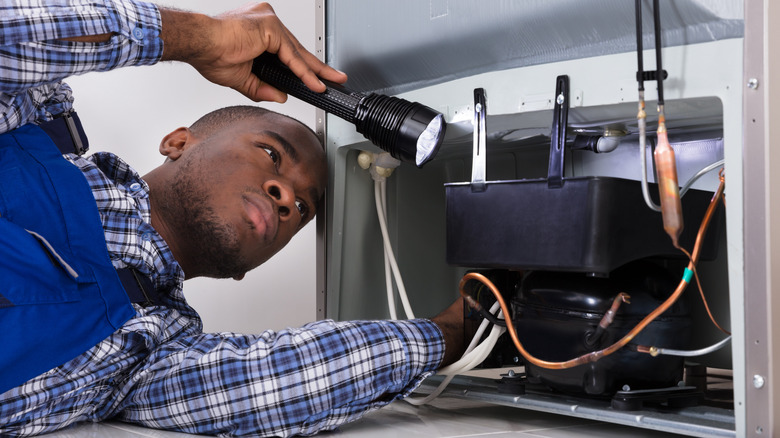Have You Cleaned Your Drip Pan? The Grossest Part Of Your Fridge Is Begging For Attention
A clean kitchen is something to be proud of, but are you smart about fridge sanitation? Most of us know that we should keep items covered in the fridge, swiftly toss out spoiled food, and sanitize the shelves, walls, and refrigerator drawers. But there's one part of your fridge that needs desperate attention, and it's probably the grossest and most neglected part — your refrigerator drip pan.
Like a glass of ice water on a hot summer day, cooling appliances, including AC units and refrigerators, create condensation. With an AC unit, this condensation typically drips outside and remains harmless, but have you ever wondered where the condensation from your fridge goes? What about overflow from the ice maker or water line? In most cases, it flows to the drip pan, where it pools under the fridge and can remain hidden for weeks on end. Learn more about the reasons why you need to check your refrigerator drip pan as soon as possible and follow these steps to keep it clean and odor-free.
Your drip pan is secretly disgusting
As you might imagine, a pool of dirty standing water isn't the most sanitary thing to have in your kitchen. Add a little warmth radiating from the underside of your fridge, and you've got the perfect paradise for fungi, mold, and bacteria to bloom. Drip pans are a very common cause of funky-smelling kitchens, and the odor from the pan can even come back into your fridge and seep into your food. If that's not disgusting enough, your drip pan can also be an attractive water source for pests, including roaches, ants, and mice, which have the potential to multiply and spread diseases around your home.
Not only that, neglecting your fridge's drip pan can cause damage to your refrigerator and your home. Normally, small amounts of water will evaporate from the pan before they cause problems. However, if left unattended for long enough, the pan can overflow and create pools of water under your fridge, damaging the floor and walls of your kitchen, risking more mold growth, and presenting an electrical hazard. Mold and bacteria buildup in the drip pan can eventually spread and clog your drain pipe, forcing excess water back up into the fridge and freezer. If you have to frequently dump the drip pan, there could be a problem with your fridge, so it's worth calling an expert to check for clogs and damaged parts.
How to clean your drip pan
Cleaning out your fridge's drip pan is a relatively simple task. Before touching anything, unplug the fridge and turn off the water to avoid accidental messes or electrical dangers. For most refrigerator models, you can access the drip pan from the front of the fridge near the floor, but some people may need to access it from the rear. Remove the grate from the front of your fridge or slide the fridge away from the walls and shine a flashlight into the motor compartment. Drip pans are usually made from metal or plastic, and some have a clear handle for easy removal, while others are held in place by bolts or screws. Carefully slide the drip pan out, check the water level, and take note of any bacterial growth.
To clean the drip pan, pour out any liquid and spray the pan with a solution of one part bleach diluted in two parts water. For dense mold growth, you may need to fill the pan with the solution and allow it to soak for a while. If you're worried about frequent mold regrowth, leave a small amount of diluted bleach in the pan and change it out frequently. Once you've thoroughly sanitized and dried the pan, you can slide it back under the refrigerator. While you're down there, take the opportunity to clean and sweep behind your fridge!


